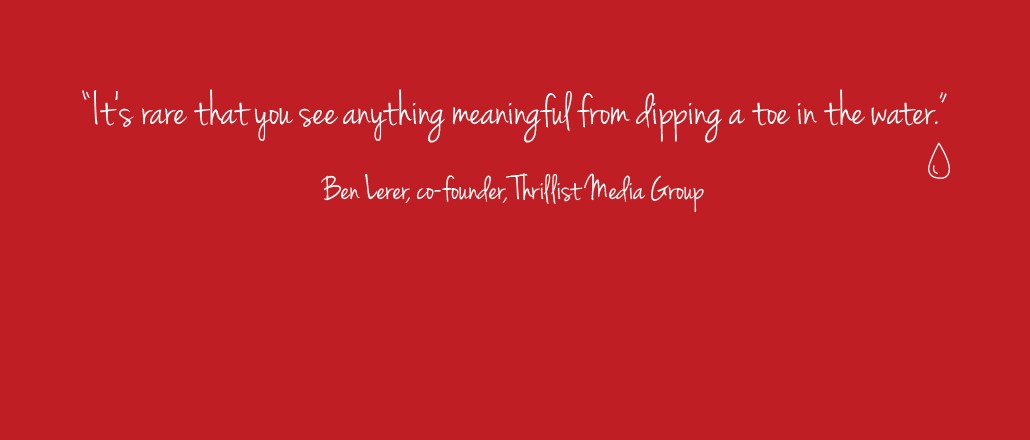Save 50% on a 3-month Digiday+ membership. Ends Dec 5.

Thrillist Media Group has come a long way from its roots as a shopping email newsletter for guys. Today, it’s a collection of men’s lifestyle blogs and newsletters and e-commerce business with revenue in the neighborhood of $100 million last year.
In our latest installment of our Executive Summary series, we talked to Ben Lerer, 33, who founded the company in 2004 with college pal Adam Rich, about the secret to mixing content and commerce successfully, why VC funding isn’t all bad — and keeping millennial employees happy.
You talk a lot lately about how traditional media need to do a better job diversifying their revenue outside advertising. What do traditional media get wrong when it comes to commerce?
It just seems like something you bolt on and it’s not thoughtfully integrated and not unique in any way. It’s, ‘can we jam some other commerce shit in here so we can make more money?’ They’re still stuck doing business the way they always have. It’s a shame they’re letting their businesses become less than extraordinary. At Thrillist Media Group, the idea isn’t, ‘let’s write about stuff and sell stuff.’ It’s, ‘let’s get people to trust us, then, separately, build a commerce business that is owned by the same business and shares systems.’
There’s something of a backlash against VC-funded media companies, what with the unrealistic growth targets. As a venture capitalist [with father Ken Lerer], what do you say to those arguments?
I don’t think this is only about media. When you’re raising venture capital, you’re signing yourself up for a mentality around growth. But in media it can definitely make you misbehave. The benefits of it are that you believe there’s a need to do things faster. The question is, to what end. Are you going to be able to generate enough ad revenue to be profitable? BuzzFeed has built an extraordinary advertising business. Do I believe there should be ways for BuzzFeed to turn that audience into things that aren’t just advertising? Absolutely. And I tell Jonah [Peretti] that when I see him. But there’s also opportunity costs and risk of distraction.

Everyone says how hard media is. Does retailing make it look easy by comparison?
They both give a lot of headaches. As an investor in 200 other companies, every business is hard. I do think doing retail and media together makes it a little easier. Figure out how to structure it to take advantage of the connection is the risk.
As a millennial-aimed company, what do you make of all the traditional players that are trying to win them over?
What The New York Times is getting right is, the pendulum has swung back to quality content being first and foremost. Media’s been democratized in that the pipes have been laid. So great content can be discovered. The best content is going to win, and the New York Times has always had the best content.
Ad position: web_incontent_pos1
But do millennials care as much as older generations where their news comes from?
I think they care less where they consume it. But at the end of the day, the best reporting does matter. I don’t think it matters if you’re young or old, you’re going to lean in the direction of that. But the best content creators can and should think about how they can be not just in the business of content creation but building their own advertisers.
Keeping millennial employees happy is a big issue for employees. What works for you?
We have a work hard, play hard culture, competitive policies, blah blah blah. The way to keep your team happy is clarity of strategy. Being really transparent. Actually build something your employees are proud to say they’re associated with. But you still have to do all that funny stuff. Lots of good happy hours. Our tech team cooks breakfast for themselves every Friday. Techfast. I think you can’t force this kind of stuff.
More in Media

Digiday+ Research Subscription Index 2025: Subscription strategies from Bloomberg, The New York Times, Vox and others
Digiday’s third annual Subscription Index examines and measures publishers’ subscription strategies to identify common approaches and key tactics among Bloomberg, The New York Times, Vox and others.

From lawsuits to lobbying: How publishers are fighting AI
We may be closing out 2025, but publishers aren’t retreating from the battle of AI search — some are escalating it, and they expect the fight to stretch deep into 2026.

Media Briefing: Publishers turn to vertical video to compete with creators and grow ad revenue in 2026
Publishers add vertical video feeds to their sites to boost engagement, attract video ad spend and compete with news creators.
Ad position: web_bfu